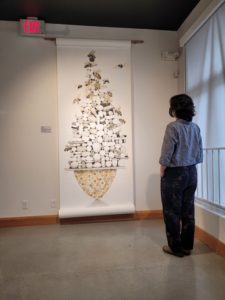A new exhibit at The Bateman Gallery sheds light on the current state of our world and how we need to start taking action now. Environmental Impact II features nature-themed art from 23 different artists, including three original pieces by Robert Bateman, the founding artist of the gallery.
“Environmental Impact is actually an exhibit that’s been curated by a gentleman in the States, David Wagner, and we have gotten lots of his exhibits in the past,” says Bateman Gallery head of curatorial Hilchie. “This one is about artists reacting to the state of our environment, specifically human action or inaction in regards to the state of our environment. It can be pretty heavy, obviously. There’s paintings of sea turtles swimming with plastic bags, and, unfortunately, this is the reality of our planet, but we felt like it was important to shed light on these issues and hope that with awareness people can reach positive change.”

Hilchie says that the exhibit features exceptionally colourful and thoughtful works that are stunning but bleak because of their honesty. She says they capture the visitor’s attention and prod at their mind, prompting a deeper look at our contribution to the earth’s state.
“A common theme is our artists took time to draw our attention to these issues and not ignore them,” she says. “They’re calling out to the viewer to stand up and pay attention. There’s a lot of blues and greens in this exhibit and I think that’s obviously because it’s an environmental exhibit. But there’s also a lot of browns and greys and blacks and I think in contrast those are the colours of our impact on the planet.”
The exhibit includes paintings and photos looking at a variety of issues, such as oil spills, decreasing water resources, and the endangerment of certain species. One of Hilchie’s favourite pieces is a 14-foot drawing called Bees Cairn by Britt Freda. It shows a stack of stones with bees crawling all over it.
“The bees are drawn with a pen that has a bit of a sheen, so they’re glowing and sparkling,” says Hilchie. “And balanced underneath the step of stones is a very delicate bee hive. It relates to that message that we need to save the bees, because so much of our ecosystem relies on tiny little insects. [It] comes to a point that everything is balancing on the point of this one hive. It’s a good reminder that our environment is so delicate and our ecosystems and food chains are so delicate as well.”
The piece evokes a lot of emotions; it’s very pleasing and whimsical. However, upon further examination it’s truly sorrowful under its layers.
“Initially at first it’s a quite charming image with the bees sparkling and the colouring that the artist chose and then, upon further reflection, you get the delicate nature of the message,” says Hilchie.
Hilchie says that she had concerns about having an exhibit that could potentially elicit depressing feelings in those viewing it. She and her team worked together to find a solution, to help visitors leave with a new perspective on their own impact of the environment without any negative emotions.
“My concern with the exhibit was that I didn’t want my visitors leaving feeling sad, or there’s this term called ‘eco grief,’ concern or anxiety for the state of our planet… I worked closely with one of my staff and our art therapist on site to create a response portion of the exhibit, where we invite visitors to do an art-therapy activity to reflect on their emotions and their feelings on the state of our Earth. We also have a resource list we put together of actionable items of what we can do.”
Environmental Impact II
Until Saturday, May 28
The Bateman Gallery
batemanfoundation.org
